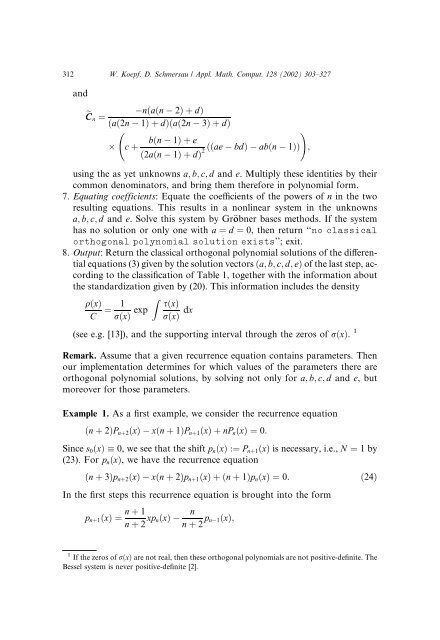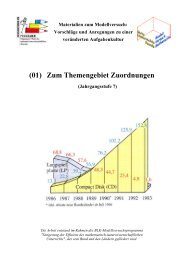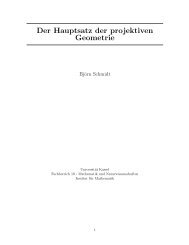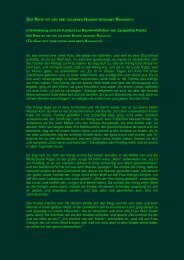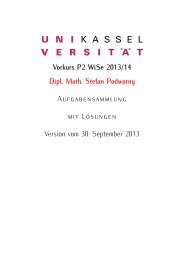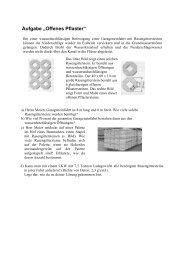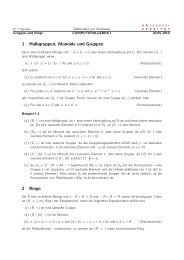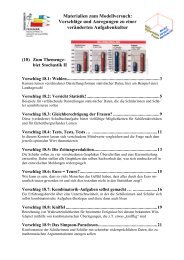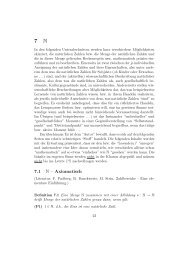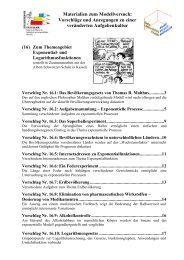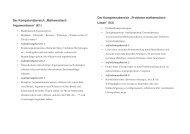Recurrence equations and their classical orthogonal polynomial ...
Recurrence equations and their classical orthogonal polynomial ...
Recurrence equations and their classical orthogonal polynomial ...
You also want an ePaper? Increase the reach of your titles
YUMPU automatically turns print PDFs into web optimized ePapers that Google loves.
312 W. Koepf, D. Schmersau / Appl. Math. Comput. 128 (2002) 303–327<br />
<strong>and</strong><br />
eCn ¼<br />
ðað2n<br />
nðaðn 2ÞþdÞ<br />
1ÞþdÞðað2n 3ÞþdÞ<br />
!<br />
bðn<br />
c þ<br />
ð2aðn<br />
1Þþe<br />
ððae 2<br />
1ÞþdÞ<br />
bdÞ abðn 1ÞÞ ;<br />
using the as yet unknowns a; b; c; d <strong>and</strong> e. Multiply these identities by <strong>their</strong><br />
common denominators, <strong>and</strong> bring them therefore in <strong>polynomial</strong> form.<br />
7. Equating coefficients: Equate the coefficients of the powers of n in the two<br />
resulting <strong>equations</strong>. This results in a nonlinear system in the unknowns<br />
a; b; c; d <strong>and</strong> e. Solve this system by Gr€obner bases methods. If the system<br />
has no solution or only one with a ¼ d ¼ 0, then return ‘‘no <strong>classical</strong><br />
<strong>orthogonal</strong> <strong>polynomial</strong> solution exists’’; exit.<br />
8. Output: Return the <strong>classical</strong> <strong>orthogonal</strong> <strong>polynomial</strong> solutions of the differential<br />
<strong>equations</strong> (3) given by the solution vectors ða; b; c; d; eÞ of the last step, according<br />
to the classification of Table 1, together with the information about<br />
the st<strong>and</strong>ardization given by (20). This information includes the density<br />
qðxÞ 1<br />
¼<br />
C rðxÞ exp<br />
Z<br />
sðxÞ<br />
rðxÞ dx<br />
(see e.g. [13]), <strong>and</strong> the supporting interval through the zeros of rðxÞ. 1<br />
Remark. Assume that a given recurrence equation contains parameters. Then<br />
our implementation determines for which values of the parameters there are<br />
<strong>orthogonal</strong> <strong>polynomial</strong> solutions, by solving not only for a; b; c; d <strong>and</strong> e, but<br />
moreover for those parameters.<br />
Example 1. As a first example, we consider the recurrence equation<br />
ðn þ 2ÞPnþ2ðxÞ xðn þ 1ÞPnþ1ðxÞþnPnðxÞ ¼0:<br />
Since s0ðxÞ 0, we see that the shift pnðxÞ :¼ Pnþ1ðxÞ is necessary, i.e., N ¼ 1by<br />
(23). For pnðxÞ, we have the recurrence equation<br />
ðn þ 3Þpnþ2ðxÞ xðn þ 2Þpnþ1ðxÞþðn þ 1ÞpnðxÞ ¼0: ð24Þ<br />
In the first steps this recurrence equation is brought into the form<br />
pnþ1ðxÞ ¼<br />
n þ 1<br />
n þ 2 xpnðxÞ<br />
n<br />
n þ 2 pn 1ðxÞ;<br />
1<br />
If the zeros of rðxÞ are not real, then these <strong>orthogonal</strong> <strong>polynomial</strong>s are not positive-definite. The<br />
Bessel system is never positive-definite [2].


